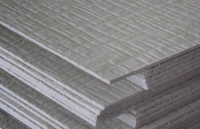








Fibre cement is a composite building and construction material, used mainly in roofing and facade products because of its strength and durability.
History
Fibre-reinforced cement-products were invented in the late 19th century by the Austrian Ludwig Hatschek. He mixed 90% cement and 10% asbestos fibres with water and ran it through a cardboard machine, forming strong thin sheets. Originally, the reinforcing fibres were of asbestos and the material was commonly used as siding in house buildings due to its low cost, fire-resistance, water tightness, light weight, and other useful properties.
In the 1970s it became widely acknowledged that exposure to asbestos is harmful to health, being directly related to a number of life-threatening diseases including, asbestosis, pleural mesothelioma (lung) and peritoneal mesothelioma (abdomen). Consequently, asbestos use was progressively prohibited and safer fibre alternatives were developed, principally cellulose, to allow continued exploitation of the widely-acknowledged advantages of fibre cement.
Fibre cement products were amongst the last materials available to have contained large quantities of asbestos. The asbestos fibres are intimately bound to the cement matrix and were considered to be immobilized in the cement and therefore less prone to be released in the environment, suspended in the air, and inhaled in the lung than in other materials or applications, such as thermal insulation or flocking, in which loose asbestos fibres were used. However, asbestos fibres are inevitably released during machining of the fibre-cement products, and by long-term erosion of the material after it has been exposed to atmospheric weathering and wind, which causes the cement to degrade. Occupational health concerns and the protection of workers in the fibre-cement factories have finally led to the progressive elimination of asbestos from these products.
Users of fibre cement boards seeking for high performance and reliable green building materials should source products having been tested by accredited laboratories and proven that they are 100% free from asbestos or other harmful materials such as sepiolite, inorganic fibre or formaldehyde.
Use
Fibre cement is a main component of long-lasting building materials. The main application areas are roofing and cladding. The list below gives some common applications.